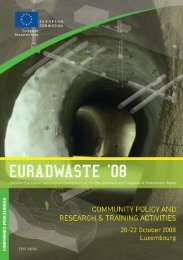EU industrial structure - EU Bookshop - Europa
EU industrial structure - EU Bookshop - Europa
EU industrial structure - EU Bookshop - Europa
You also want an ePaper? Increase the reach of your titles
YUMPU automatically turns print PDFs into web optimized ePapers that Google loves.
The calculations of vertical specialisation assume that all<br />
imports originate in other countries and do not take into<br />
account that parts of imports may consist of products that<br />
originally are domestic. If, for example, Spain imports an<br />
electronic good and a component in that good previously<br />
was produced and exported from Spain, Spanish imports of<br />
TAbLE IV.14: Indicators of RCA for manufactured goods in 2000 and 2009<br />
that good appear as larger than they actually are. This then<br />
overestimates the vertical specialisation for Spain. 82<br />
Considering that an industry’s exports may include a large<br />
proportion of imports, the validity of the traditional way to<br />
measure the external competitiveness of industries must be<br />
in doubt. The RCA‑indices presented above do not take into<br />
account that a large part of the exports can be produced in<br />
another location.<br />
Competitiveness is assessed below using an adjusted<br />
measure of revealed comparative advantages (RCA). The<br />
adjusted RCA measures are calculated for different types<br />
of goods defined according to the basic classes of goods<br />
in the system of national accounts (SNA): intermediate<br />
goods, capital goods, consumer goods and goods not<br />
else classified (goods n.e.c.). 83 The adjusted RCA measures<br />
are calculated for both exports and imports. Especially<br />
interesting is the measure for imports of intermediates<br />
which shows whether a country has comparative advantage<br />
of assembly. 84<br />
82 Kommerskollegium (2010). See also Hummels et. al. (2001) for<br />
a more detailed discussion.<br />
83 The categories of goods in SNA consist of aggregation of the<br />
goods classified according to the Broad Economic Category (BEC)<br />
classification. BEC consists of seven types of goods: consumer<br />
goods, capital goods, <strong>industrial</strong> supplies, fuels, transport<br />
equipment, food and beverages and goods not elsewhere<br />
specified.<br />
84 See OECD (2010) and Ng and Yeats (1999) for discussions of these<br />
RCA measures.<br />
Chapter IV — International competitiveness of <strong>EU</strong> industry<br />
Beginning with the very broad categories of manufactured<br />
goods, China is the only country without comparative<br />
advantage in intermediate exports. Chinese and<br />
Indian industries seem to be dependent on imports of<br />
intermediate goods which are indicated by the high RCA<br />
indicator for intermediate imports, cf. Table IV.14.<br />
intermediate goods consumption goods capital goods goods nec<br />
Exports imports Exports imports Exports imports Exports imports<br />
2000 2009 2000 2009 2000 2009 2000 2009 2000 2009 2000 2009 2000 2009 2000 2009<br />
Eu‑27 1.2 1.1 1.0 0.9 0.5 0.5 0.9 1.1 1.7 1.7 1.0 0.9 1.8 1.6 1.1 1.2<br />
Brazil 1.5 1.7 1.2 1.1 0.5 0.4 0.5 0.6 1.2 0.7 1.1 1.2 0.5 0.6 0.4 0.6<br />
china 0.9 0.9 1.4 1.4 1.1 0.8 0.1 0.1 1.2 2.3 1.0 1.1 0.2 0.2 0.2 0.3<br />
india 1.4 1.3 1.6 1.5 1.0 0.9 0.2 0.2 0.2 0.7 0. 5 0.8 0.4 0.6 0.2 0.3<br />
Japan 1.4 1.5 1.1 1.1 0.2 0.2 1.3 1.2 2.3 2.0 0.7 0.7 0.6 0.5 0.5 0.4<br />
russia 2.3 2.2 0.9 0.6 0.1 0.1 1.3 1.6 0.3 0.2 1.2 1.5 0.1 0.8 0.2 1.0<br />
usa 1.4 1.3 0.8 0.8 0.4 0.4 1.2 1.3 1.8 1.2 1.1 1.2 1.2 2.4 1.8 1.3<br />
Source: own calculations using COMTRADE data.<br />
In the table above, very broad categories of manufactured<br />
goods were analysed. While these aggregates provide<br />
some useful information regarding specialisation patterns<br />
across countries, the aggregates necessarily mean that<br />
industry differences are hidden. Looking more closely<br />
at a disaggregation of intermediate goods allows for<br />
separation of manufactured goods into a classification<br />
according to technological intensity. Of the BRIC countries,<br />
only China seems to have comparative advantages in<br />
exports of high‑tech intermediate exports. The high RCAs<br />
for imports indicate that China also has comparative<br />
advantages in the assembly of intermediate goods in<br />
medium high‑tech and high‑tech industries. 85 However,<br />
the <strong>EU</strong>, Japan and the US also have comparative advantages<br />
in assembling high‑tech goods, although not to the same<br />
extent. The results in the table below are therefore not<br />
conclusive on this point, cf. Table IV.15.<br />
85<br />
where int denotes intermediate goods, i industry and c country.<br />
See Ng and Yeats (1999) and OECD (2010) for a discussion of this<br />
indicator.<br />
127
















